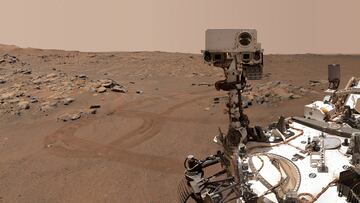What organic particles has the Mars rover detected and what does it mean for the search for extraterrestrial life?
Mankind’s quest to find life beyond our little blue planet has led to several missions to Mars, the latest reveals evidence of diverse organic compounds.

Since February 2021, the Mars Perseverance rover has been collecting and studying soil samples in the Jezero Crater on the Red Planet. The location was chosen due to its high potential of having been habitable in the past as it was once an ancient lake basin. Likewise, the site includes conditions that “may preserve organic materials and potential biosignatures.”
There is the hope to study the samples that are being collected and stored onboard the rover back here on Earth some time in the future. The Mars Sample Return Mission however, will take many years and be an ambitious and complex mission as a video mockup from NASA shows.
In the meantime though, scientists are using a new device called SHERLOC (Scanning Habitable Environments with Raman & Luminescence for Organics & Chemicals) to carry out their research remotely on the Red Planet. A new study published in Nature by a team of researchers that includes University of Florida astrobiologist Amy Williams found evidence diverse organic compounds.
What organic particles has the Mars rover detected and what does it mean for the search for extraterrestrial life?
The Mar Perseverance mission is just the latest by NASA to explore the Red Planet in search of indicators that life once existed there. Specifically, scientists are searching for organic carbon, which until present, have only been detected by the Mars Phoenix lander and the Mars Curiosity rover.
Those missions used advanced techniques like evolved gas analysis and gas chromatography-mass spectrometry. However, the Perseverance rover has SHERLOC aboard which employs deep ultraviolet Raman and fluorescence spectroscopy. The first-of-its-kind instrument can simultaneously measure weak Raman scattering and strong fluorescence emissions that can identify simple organic compounds and provide key understanding of the Martian organic composition.
“We didn’t initially expect to detect these potential organics signatures in the Jezero crater floor. But their diversity and distribution in different units of the crater floor now suggest potentially different fates of carbon across these environments,” said Williams, an expert in organic geochemistry.
The Assistant Professor of Geology at UF has been at the forefront of the search for the building blocks of life on Mars. She and three PhDs working with her have been participating scientists on the Perseverance mission.
Notably, at two targets, Guillaumes (Máaz) and Garde (Séítah), the the research team detected organic features and minerals associated with aqueous processes, particularly apparent at the latter. This would indicate that water played a crucial part in the diverse range of organic matter on Mars. Furthermore, it appears that the key building blocks necessary for life may have continued on the Red Planet for far longer than previously thought.






